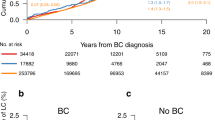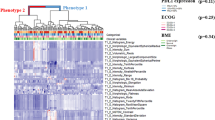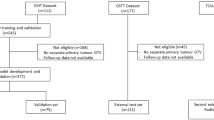Abstract
A number of randomized studies have been carried out in the UK and USA to determine the optimal radiotherapy dose schedule for advanced non-small-cell lung cancer (NSCLC). We have examined eight radiotherapy regimens from data taken from four randomized phase III studies carried out in the UK (1264 patients): 10 Gy single fraction; 17 Gy in two fractions over 8 days; 30 Gy in ten fractions over 14 days; 22.5 Gy in five fractions in 5 days; 27 Gy in six fractions over 11 days; 30 Gy in six fractions over 11 days; 36 Gy in 12 fractions over 16 days; and 39 Gy in 13 fractions over 17 days. We compared the clinical results in palliation, toxicity and survival with four regimens taken from one randomized study from the USA (365 patients): 40 Gy in 20 fractions over 4 weeks; 40 Gy 'split course' in ten fractions in 4 weeks; 50 Gy in 25 fractions over 5 weeks; and 60 Gy in 30 fractions over 6 weeks. Using the linear-quadratic (LQ) radiobiological model, we have calculated the radiobiological equivalent dose (BED) for acute-reacting tissues (BED10), late-reacting tissues (BED1.7) and tumour (BED25), and related the predicted response to the observed response in each tissue. There was a good correlation between the predicted response and the reported response in the case of late-reacting tissue toxicity and tumour response. The model confirmed that, in good performance status patients, a higher value for BED25 correlated with a higher degree of local control and survival and that radiotherapy regimens with a higher value for BED1.7 were associated with five cases of cord myelopathy, if the spinal cord was not shielded. In poor performance status patients the model suggested that the optimal regimen was a single fraction of 10 Gy because this resulted in an equivalent degree of symptom control as other regimens, needed only one hospital visit and was less likely to result in cord damage, thus, allowing for the possibility of retreatment at a later date.
This is a preview of subscription content, access via your institution
Access options
Subscribe to this journal
Receive 24 print issues and online access
$259.00 per year
only $10.79 per issue
Buy this article
- Purchase on Springer Link
- Instant access to full article PDF
Prices may be subject to local taxes which are calculated during checkout
Similar content being viewed by others
Author information
Authors and Affiliations
Rights and permissions
About this article
Cite this article
Singer, J., Price, P. & Dale, R. Radiobiological prediction of normal tissue toxicities and tumour response in the radiotherapy of advanced non-small-cell lung cancer. Br J Cancer 78, 1629–1633 (1998). https://doi.org/10.1038/bjc.1998.734
Issue Date:
DOI: https://doi.org/10.1038/bjc.1998.734
This article is cited by
-
Of what use is radiobiological modelling?
Australasian Physics & Engineering Sciences in Medicine (2009)
-
The use of the linear quadratic model in radiotherapy: a review
Australasian Physics & Engineering Sciences in Medicine (2001)



